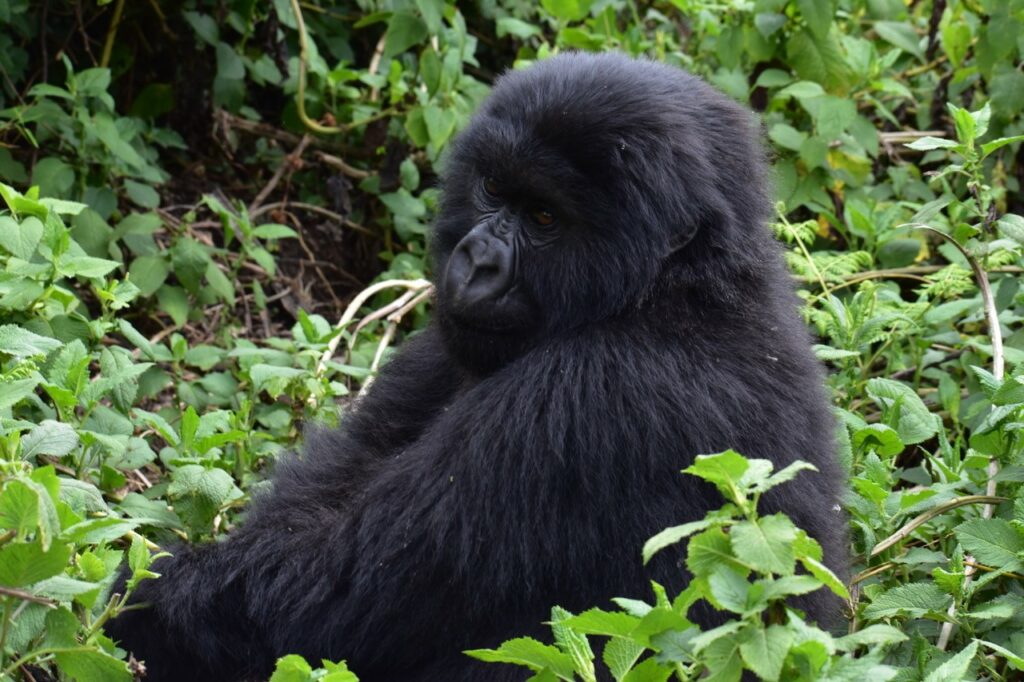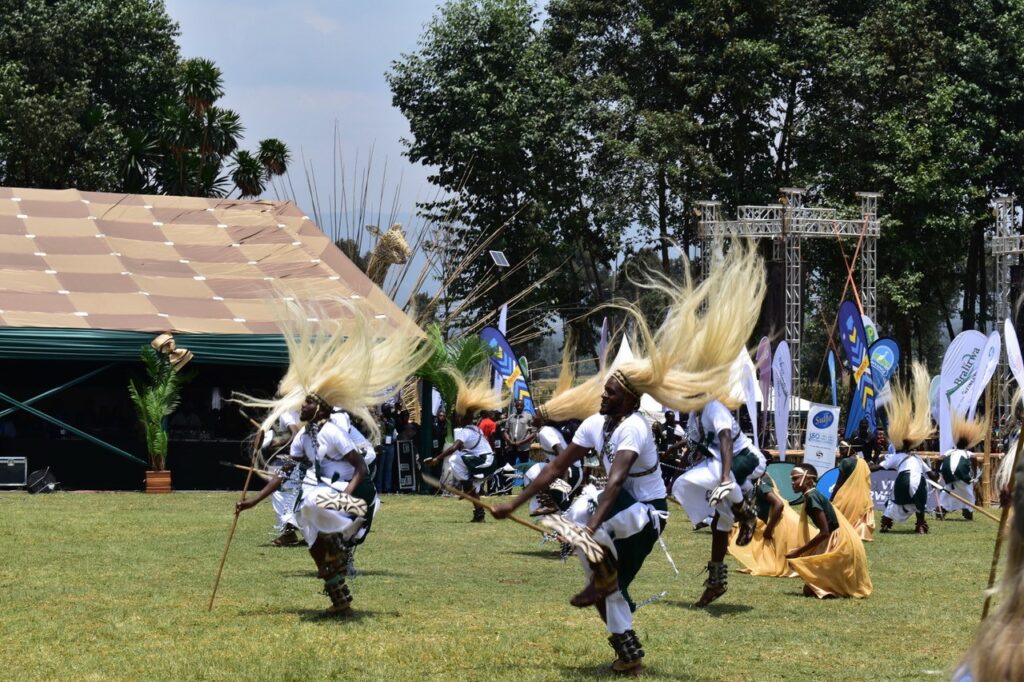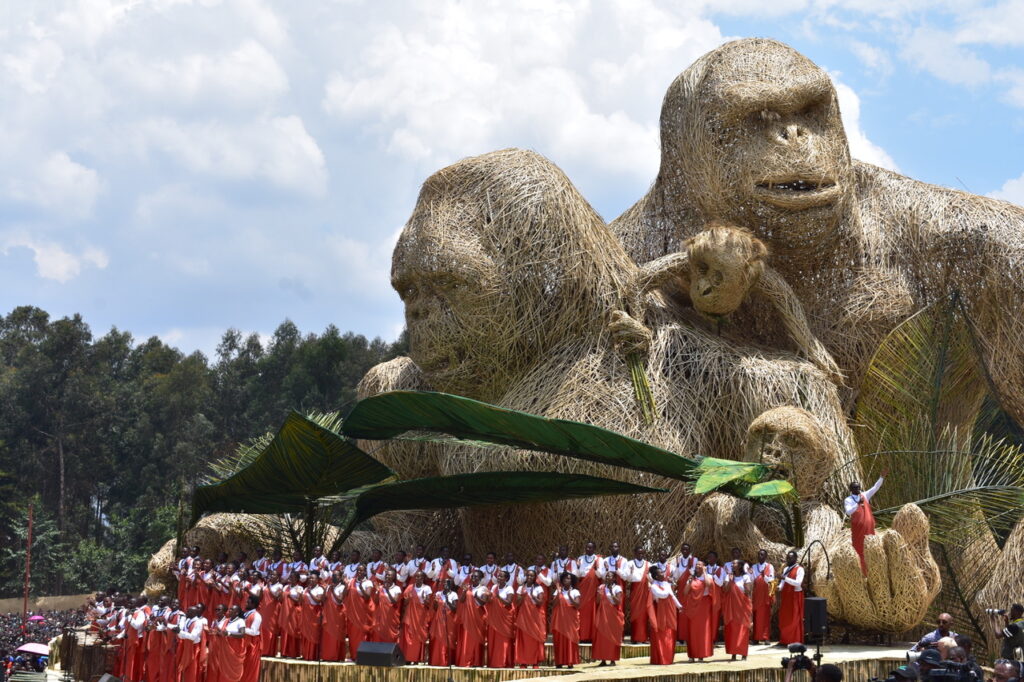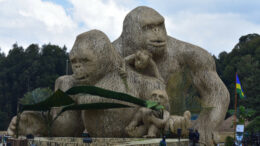MUSANZE, Rwanda— Before daybreak on the first Friday in September, a procession of large black cars hurtling through the mountain passes makes for a curious sight. Many of the people walking toward the fairgrounds in Musanze, at the foothills of Volcanoes National Park, turn and wave. Within a few hours, the cars and the pedestrians both slow to a crawl as they merge with the tens of thousands of people who have come to Musanze to join the annual event known as Kwita Izina, a ceremony that celebrates the baby gorillas born in the previous year.
Attended by national and international luminaries, the celebration is marked by jubilant singing and dancing, extravagant displays, and reflection on what can only be deemed a conservation success.
It wasn’t always this way.
Beginning in the days of famed primatologist Dian Fosse, when poaching was the greatest threat facing mountain gorillas, the naming of baby mountain gorillas in Volcanoes National Park was an academic affair. Once a year park rangers would gather around a campfire and select a name based on the baby’s nose print, its family, emerging personality, and current events. That personal identifier would be added to Fosse’s Karisoke Research Center database to help monitor and track gorilla populations.
It was an intimate event, little known outside ranger circles, until a humble request for snack money transformed this simple naming ceremony into an international phenomenon that at its core is still distinctly Rwandese.
Rosette Chantal Rugamba, who I met while waiting in line at Kwita Izina, tells me she remembers the request well. She was serving as the head of Office of Rwanda Tourism and National Parks in 2003 when a budget application crossed her desk for a “fun evening of naming.”
“I was instantly intrigued,” she recalled recently during a follow-up video interview. “I asked them, am I invited? And they said no, it is a park thing. It is very private and scientific. And I said, is anybody invited? They said no. And I said how long have you been doing it? They said, for a very long time. I said, and nobody comes? And they said no, it is just a park thing.”
“And I thought, this is the best news I’ve heard.”
Recovering From Darker Days
It was less than a decade after the 1994 genocide against the Tutsi in Rwanda, a brutal time when the mountain gorillas’ habitat straddling Uganda, Rwanda, and Democratic Republic of Congo became a battleground. Wildlife rangers themselves became targeted and killed, and Karisoke was destroyed. During the genocide poachers aggressively targeted mountain gorillas. Because mountain gorillas travel in tightly knit families, poachers wanting to steal a baby gorilla often had to kill the entire family. So many were killed that their status on the International Union for Conservation of Nature and Natural Resources’ Red List of Threatened Species fell from endangered to critically endangered.
In the years that followed, aggressive anti-poaching and protection efforts had led to a slow increase in the gorilla population. In combination with successful ecotourism efforts, poaching was virtually eliminated. Several former poachers were hired as trackers to lead tourists to habituated mountain gorilla families.

By the time the request for funds crossed Rugamba’s desk in 2003, she saw the informal naming ceremony as evidence that enough new babies were being born and populations were again increasing. It was, she believed, cause for celebration.
“It was a conservation success. When a gorilla is born that means something is going right for this highly endangered national species,” Rugamba says. “But we also knew that if we wanted to continue to succeed in conservation, we needed to realize that our success was a fragile success. We are privileged to be the custodian of these wonderful creatures, but they belong to the world.”
Working with the country’s tourism board, the president’s office, communities surrounding the park and the rangers themselves, Rugamba and her team decided to reframe the event. Much to the bemusement of the rangers, it took nearly two years to plan a ceremony fit for the country’s highest-level officials. The first public gathering was held in 2005, when the area outside the park lacked basic infrastructure like hotels and restaurants. To compensate for this, the government implemented the Tourism Revenue Share Fund, which directed 10% of the country’s park revenues to go back to the communities near each national park to help support economic development.
By the third year, the event had grown and was televised around the world. It was then that the ceremony was renamed Kwita Izina, after the Rwandese tradition of a family gathering to announce the arrival of a new infant. Adopting the ceremony’s name, and modifying the tradition, to celebrate mountain gorillas as a nation was, Rugamba says, an easy sell.

“As much as it was becoming an international event, we wondered, how do we keep it local? How do we keep it authentic?” she says. “We realized mountain gorillas are our children. These are our most treasured wildlife. Why not gather as a family, as a nation, and give them the same welcome that we give to Rwanda’s children when they are born?”
In the years since that first public Kwita Izina, the mountain gorilla population has continued to increase. At the most recent gorilla census in 2018, the population in both the Virunga Massif and Bwindi-Sarambwe subpopulations totaled 1,063, resulting in it moving from “critically endangered” back to “endangered” on the IUCN Red List. The census is completed approximately every five years, with the next due to be completed this year. Despite the increasing population, though, mountain gorillas still face threats from disease, climate change and habitat encroachment.
Growth Continues
Last year more than a dozen gorilla families welcomed new babies, with 23 being named at the 19th annual Kwita Izina. The babies are members of the Dushishoze, Agashya, Pablo, Isimbi, Hirwa, Ntambara, Segasira, Musirikari, Kwitonda, Igisha, Muhoza and Sabyinyo families.
As these families grow, so does tourism revenue. Rwanda generated $247 million in the first half of 2023 (the latest figures available). Gorilla tourism was the largest share of that, according to the Rwanda Development Board. Through the Tourism Revenue Share Fund, proceeds have been used to build schools, water facilities, housing for vulnerable families, modern markets, and community health centers.
It’s no surprise, then, that the ceremony celebrating what Rugamba saw as a conservation success in 2003 is also getting bigger each year. RDB estimated that 30,000 people attended the annual ceremony in 2023, when locals and luminaries from around the world turned out in droves.
Names Have Power
In addition to the sheer increase in scale, one of the most significant changes since the naming ceremony’s humble beginnings is the presence of “namers,” celebrities invited by the government to ceremonially adopt the baby mountain gorillas and present their new names. The individual names are still chosen by the rangers, around a campfire at night with no one else in attendance. (The babies and their families do not attend the public event themselves — a popular misconception.)
Namers are invited to reflect on what a particular name may mean to them. In 2023 namers included Rwanda’s 2022 National Geographic Society Young Explorer Grace Ineza Umuhoza; Denmark billionaire Anders Holch Povlsen; Audrey Azoulay, director general of UNESCO; American comedian and actor Kevin Hart; and United Nations Goodwill Ambassador Sabrina Dhowre Elba and her husband, actor and DJ Idris.

“On a number of levels, the ceremony impacted me at the true grassroots, the way people have really fallen in love with the gorillas,” says 2023 namer Larry Green, chair of the African Wildlife Foundation’s global board. “Protecting them is so much a part of Rwandan culture. When you have people and the land and the animals all working in harmony, this is what good looks like.”
Green’s baby name was Ingoboka, which is Rwandese for “support.”
“The rangers had come up with the name, and they were thinking of the way in which a new baby coming into a family supports the health of the family. And this family in particular has lost some babies along the way,” Green says. “As I thought about what the word meant, I thought about the amazing support that the gorillas provide for the people and the people provide for the gorillas.”
Countering another false impression about the ceremony, Green and Rugamba both state unequivocally that namers are not selected based on donation size. While Green admitted he made a “sizable” contribution to the Volcanoes National Park expansion project (he declined to disclose the amount), he says he was not asked for a donation as a condition of being invited, nor was he asked for an ongoing commitment to the gorillas.
He has, however, returned to Rwanda since Kwita Izina, and went tracking again. The park warden arranged for him to go see Ingoboka’s family and he was able to visit with the baby he had adopted. Since his return to the United States, he’s stayed in touch with one of the trackers on Whatsapp, and she regularly sends him videos and photos.
“So in a way I have an ongoing insight into how this baby is growing and evolving,” Green says. “It’s really amazing.”
Twenty years after that first requisition request for snacks around a campfire, Rugamba runs Songa Africa, a tourism company and lodge. She still attends Kwita Izina each year, although she no longer plays a formal role.
“I absolutely could not imagine what I am seeing now. I am smiling because it is not only a conservation success, but it is a Rwanda success because we did it as a country,” Rugamba says. “A seed was planted, it was well nourished with lots of watering, lots of manure, and it continues to flourish.”
Molly McCluskey traveled to Kwita Izina at the invitation of the Embassy of Rwanda in Washington. She first tracked the gorillas as an IWMF fellow in the DRC in 2014.
Previously in The Revelator:
How (and Why) I Planned a 40-City Book Tour About Shark Science and Conservation


